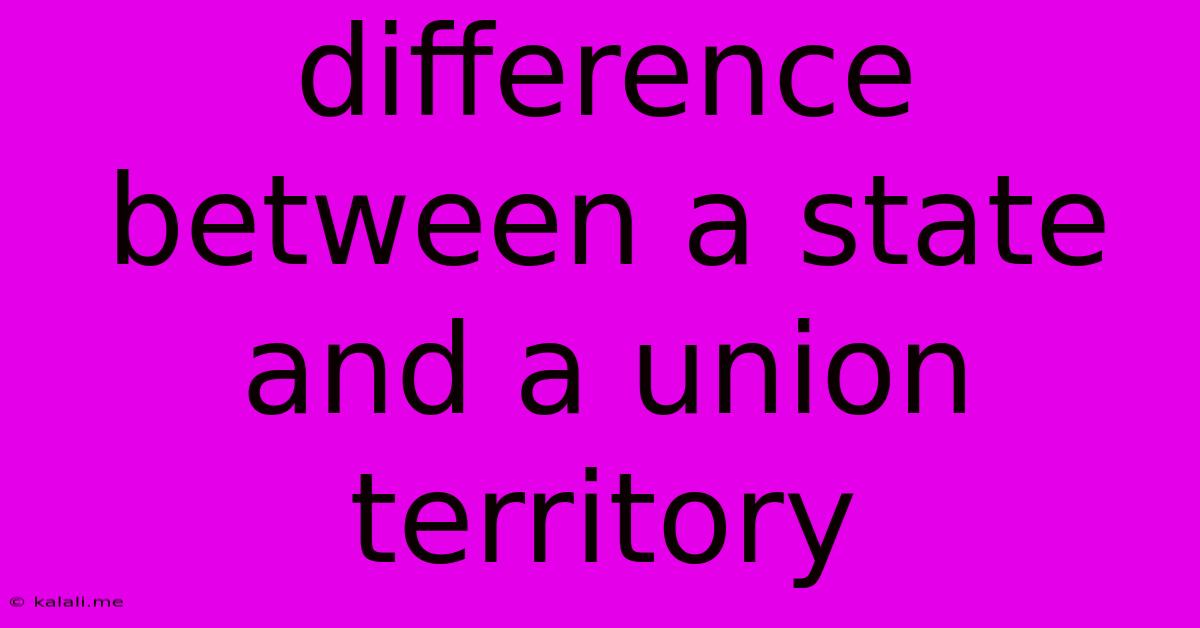Difference Between A State And A Union Territory
Kalali
Jun 14, 2025 · 3 min read

Table of Contents
Understanding the Difference Between a State and a Union Territory in India
India's political landscape is composed of states and union territories, two distinct administrative entities with differing levels of autonomy. While both are integral parts of the Indian Union, understanding their key differences is crucial for comprehending the country's governance structure. This article delves into the core distinctions between states and union territories, exploring their legislative powers, administrative control, and overall political significance.
What is a State?
A state in India is a first-order administrative division, enjoying significant autonomy and self-governance. States are represented in the Indian Parliament and have their own elected governments, responsible for managing most aspects of their internal affairs. This includes law and order, education, healthcare, infrastructure development, and local governance. The legislative powers of a state are extensive, as defined by the Indian Constitution, encompassing a wide range of subjects. Statehood grants a high degree of self-determination within the framework of the national government. The Governor, appointed by the President of India, is the head of the state, while the Chief Minister, chosen by the majority party in the state legislature, heads the state government.
What is a Union Territory?
A union territory, in contrast, is directly governed by the central government in New Delhi. Unlike states, union territories do not have the same level of legislative autonomy. The extent of their self-governance varies depending on the specific union territory. Some, like Delhi and Puducherry, have elected assemblies and limited legislative powers, while others are administered directly by the central government through a Lieutenant Governor. The central government holds significant sway over all aspects of administration, including law and order, finance, and the development of infrastructure. Union territories are typically smaller in size and population compared to states and often have unique geographical or strategic importance.
Key Differences Summarized:
Here's a table summarizing the key differences between states and union territories in India:
| Feature | State | Union Territory |
|---|---|---|
| Governance | Elected state government | Directly ruled by Central Government |
| Legislative Power | Extensive, defined by the Constitution | Limited or none, depending on the UT |
| Head of State | Governor (appointed by the President) | Lieutenant Governor (appointed by the President) |
| Head of Government | Chief Minister (elected) | Administrator or Chief Minister (if applicable) |
| Representation in Parliament | Full representation in both houses | Limited or no representation in the upper house |
| Autonomy | High | Low to moderate |
Why the Distinction Matters:
The difference between states and union territories is more than just an administrative detail. It directly impacts the political power dynamics and the level of self-governance enjoyed by the population within each territory. The varying degrees of autonomy influence policymaking, resource allocation, and the overall development trajectory of these regions. The classification also reflects historical, geographical, and strategic considerations in the organization of India's diverse administrative structure.
Conclusion:
Understanding the nuances between a state and a union territory is key to appreciating the complexities of India's federal structure. While both are integral parts of the nation, the levels of autonomy and self-governance differ significantly, influencing the political landscape and development of each region. This distinction highlights the careful balance between central authority and regional self-determination that defines India's unique political system.
Latest Posts
Latest Posts
-
Intellectual Disabilities Are Characterized By Significant Limitations Both In
Jun 15, 2025
-
L I M In P India
Jun 15, 2025
-
A Chisel Used To Cut V Grooves And Square Corners
Jun 15, 2025
-
What Is The Least Common Multiple Of 6 And 24
Jun 15, 2025
-
What Is The Smallest Unit Of Data In Computer
Jun 15, 2025
Related Post
Thank you for visiting our website which covers about Difference Between A State And A Union Territory . We hope the information provided has been useful to you. Feel free to contact us if you have any questions or need further assistance. See you next time and don't miss to bookmark.